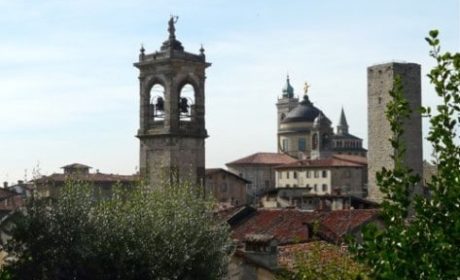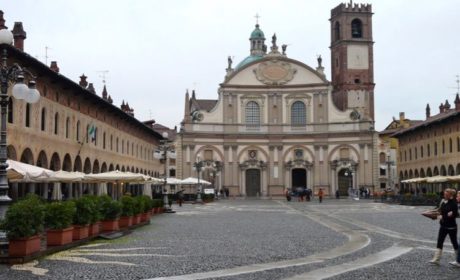On a visit to Matera, Italy, history grabs you by the hand and says, “come walk with me.” And it’s not hard to do. Use our experience to create your personal self guided walking tour of Matera.
Alan and I explored Matera with our guide, Claudio Fontana, of A La Carte Italy Tours. While planning our Southern Italy road trip itinerary, Claudio suggested stopping by this off-the-beaten-path city that borders Basilicata and Puglia for a quick look-see.
We were traveling from Gallipoli to Salerno on the next-to-last day of an amazing boomer travel adventure.
Alan and I expected the city walking tour of Matera to be something to fill our time and break up the drive. Instead, we discovered a fascinating historical site that deserved more attention than a mere half day.
Matera Walking Tour

Peering from the edge of the historic center in modern-day Matera, the caves and stone dwellings of the Sassi settlements spread out before visitors, housed in two ravines on either side of the Duomo.
A walk down steep, uneven steps offers evidence of one of the first human communities in Italy, dating back to the troglodyte era of prehistoric times according to Michelin Green Guide Italy. No wonder the area was named a UNESCO World Heritage Site in 1993.
Boomer Travel Tip
MedjetAssist Members who are hospitalized 150 miles from home receive medical transport to a home-country hospital of choice. Memberships from $99.
Free guided tour of the Roman cistern
After purchasing yet another cappuccino at a local café as an excuse to use the facilities (Italy has very few public restrooms), we waded into the All Saints Day holiday crowd in Piazza Vittorio Veneto.
At an iron railing, Alan, Claudio and I looked down into the entrance to one of the Roman cisterns used to provide water in earlier times.

To satisfy our curiosity, we walked down the stairs to join a free guided tour being offered that included commentary from an English speaking guide. Footsteps echoed as the group climbed down the stairs and negotiated a catwalk built over the vast cistern.
The cistern’s huge size, along with the knowledge that another civilization much older than ours also knew how to use technology albeit primitive, was humbling.
Boomer Travel Tip
In today’s travel climate, trip insurance is a must. Compare policies and rates at InsureMyTrip.
Explore the Sassi settlements
Exiting the cistern tour, we walked the few short steps to a patio overlooking the Sassi settlements that tumble down the ravines in a jumble of cave and stone dwellings. Steep, stone steps beckoned for us to explore and we obliged.
On the way down, the open mouth of a cave revealed faint traces of frescoes still visible on the walls.
A visit to the Sassi sites requires uphill and downhill walking on rough, stone steps and pathways. The journey requires sturdy knees, lungs, and good walking shoes.
The walk would be slippery during the rain. It is not handicap accessible.

The term “Sassi” does not refer to the stone and cave dwellings, as you might expect, but to the two communities that housed them. Humans have lived here continuously since prehistoric times as history, wars and politics evolved around them. And the cave dwellings evolved too, becoming the base for more elaborate structures, one built on top of the other.
Poverty flourished in the Sassi settlements during the 1900’s. In his 1945 memoir, Christ Stopped at Eboli, Carlo Levi revealed the less than humane living conditions.
The Italian government finally relocated the approximately 20,000 inhabitants to modern day Matera in 1952. The Sassi remained deserted, except for a few hippie residents until 1986, when restoration efforts slowly began.

Mel Gibson filmed The Passion of the Christ here due to the area’s resemblance to Jerusalem, giving the ancient town of Matera another publicity boost. On our visit, we found restaurants, galleries, local residences and bed and breakfasts scattered about the Sassi.
Boomer Travel Tip
Want to see more details about our incredible trip through Southern Italy? Check out our entire Southern Italy road trip experience day by day!
Visit the rock churches
After spending 11 days in southern Italy, we were churched out. That was unfortunate since 155 rupestrian (rock) churches are located in Matera and the surrounding area, many with frescoes.
The rock churches are best toured with a guide. Since the churches are spread out, you’ll need a car to explore them.
And be sure to check out the view of the city. Matera is located across the canyon from the churches.
Climbing up and out of one Sassi, we stopped to pose for photos in front of the Duomo (cathedral) before plunging back down into the second settlement.
Stop for lunch

After another climb up, up, up, we arrived at the top of the ravine near Lacapagria on Via D’adozzio. The restaurant was a good place to stop for a late lunch.
Alan and I enjoyed the outstanding sampling of fresh, local products. Observing the chef carefully arrange the meats and cheeses that made up our plate of antipasti was like watching an artist at work.
Too soon, it was time to continue the drive for an overnight stay in Salerno, Italy.
Alan and I would definitely like to return to spend several days in the luxurious Sextanteo Le Grotte della Civita located near Sasso Caveoso.
Can you imagine what it would be like to experience the Sassi at night when the tourists have departed?



